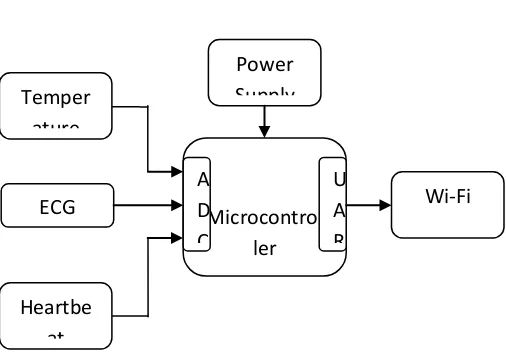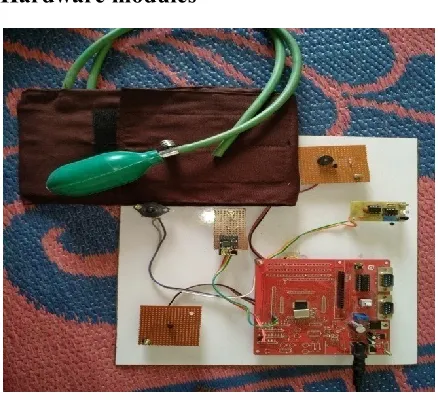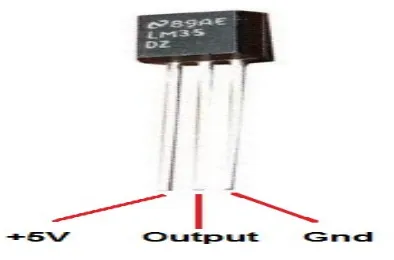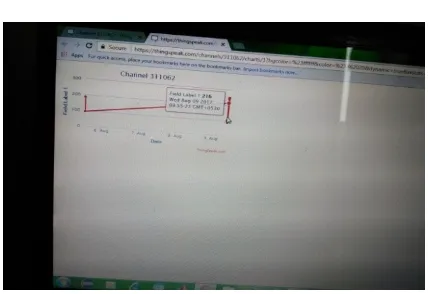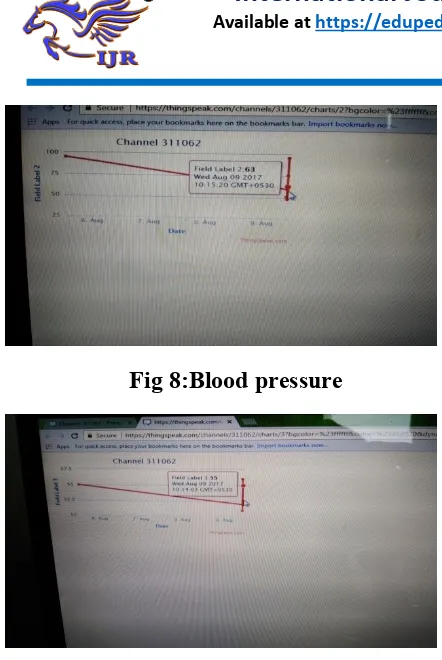A Secure Iot Based Modern Health Care System Using Body
Sensor Networks
Mosin.S K & Vinatha.G
PG Scholar, Dept of ES, Assistant Professor, Dept of ECE Vinnu251@gmail.com, raheemshaik789@gmail.com
St. Martins Engineering College, Jawaharlal Nehru Technological University, Hyderabad, Telangana, India.
Abstract
Now a day people are facing many health related problems. There is large amount of data that is not structured. The gathered information is raw and unstructured in the nature, so there is a need of converting it to meaningful services. In this project such system is developed which will provide web service that will be available to any other person easily. Every person should get the healthcare services anywhere, every time even at their home also. For this purpose a platform is developed so that patient especially senior citizens can know their electro Cardiogram (ECG) web page developed for the healthcare.
This overall concept is developed under the Internet of Things and on raspberry pi board. Web page which is developed named as ‘Patient Health Monitoring’. This prototype is realized with off-the-shelf components: i) ECG prototype sensors with record-low energy per effective number of quantized levels, ii) an architecture providing low marginal cost per added sensor/user, iii) the possibility of seamless integration with other smart home systems through a single internet-of-things infrastructure. Keywords: Internet of things, health monitoring,.
Introduction:
The main concept used in order to describe the world of the Internet of Things refer to the devices and everyday objects, from small ones (like wrist watches and medical sensors) to really big ones (robots, cars, and buildings). All such contain devices that interact with users by
generating and retrieving information about and from their environment. They also
contain hardware that allows them to control outputs (like relay switches or digital ports). The definition of IoT can be expressed in many ways, the idea behind every IoT technology and implementation is the same, devices are integrated with the virtual world of the internet and interact with it by tracking, sensing and monitoring objects and their environment. Users and developers add components, give them sensing and networking capabilities, program them to perform the desired tasks and build Web applications that interacting with the devices.
The features of a device that can act as a member of an IoT network can be summarized in to the following:
Collect and transmit data: The device
can sense the environment (e.g., your home or your body) and collect information related to it (e.g., temperature and lighting conditions) and transmit it to different devices (can be mobile phone or laptop) or to the internet.
Actuate devices based on triggers: It can be programmed to actuate other devices (e.g., turn on the lights or turn off the heating) based on the conditions set by the user. For instance, user can program the device to turn on the lights when it gets dark.
Receive information: One unique
also receive information from the network they belong to (i.e. other devices) or through the internet (e.g., information from the users like new trigger, new status of operation and in some cases new functionality).
Communication assistance: IoT
devices that are members of a device network can also assist in communication (i.e. data forwarding) between other nodes of the same network. Think of them as messengers for devices (nodes) that are not very close to an endpoint (e.g., router) in order to get direct information from.
The below Figure 2 illustrates the Internet of Things. „Things‟ consisting of various sensors and actuators interact with environment and the Internet allowing users to manage them and their data over various interfaces.
Fig 1: An illustration of the Internet of Things
The ability to communicate (most usually) directly or indirectly to the internet makes IoT devices different than ordinary sensor devices. There are many questions like what are the main reasons a device would need to communicate with an internet service? What kind of service would that be and what kind of features would it have?
Firstly, sensors generate a lot of data that needs somehow to be managed. Usually, embedded memory is quite limited for storing sensors data continuously. There are some alternative solutions like storing on memory cards, or in computers in case sensors are directly connected
to them. Since sensors can be integrated to devices with further networking capabilities, the possible way is to store the information online.
Literature Survey:
Brain-Machine Interfaces (BMI) or Brain-Computer Interfaces (BCI), also referred to as Neuro-Prostheses, are conceived as technological interfaces between a machine (usually a computer) and the brain of a user. They should permit the use to perform a certain task, usually without implementing any motor action. This implies that neural impulses generated by the user‟s brain are detected, elaborated and utilized by the machine, approximately in real-time, to perform definite tasks. As an example, information can be processed and employed to control mechanical systems (e.g. actuators) or electrical devices (e.g. electronic equipment).
Brains are characterized by every property that engineers and computer scientists detest and avoid. They are chaotic, unstable, non-linear, non-stationary, non-Gaussian, asynchronous, noisy, and unpredictable in fine grain, yet undeniably they are among the most successful „devices‟ that evolution produced.
A great demand for brain-machine interfaces is arising nowadays, pushed by several promising scientific and technological recent results, which are encouraging the concentration of efforts in such a direction. The possibility of measuring, processing and decoding brain activity, so that to interpret neuronal signals, is regarded as the challenging possibility of bypassing damaged neural and/or motor structures in patients affected by motor disorders and paralyses.
systems of different type, such as computer virtual keyboards, home electronic equipment or aid system (e.g. wheel chairs), certainly represents one of the main goals of this discipline. Moreover, neuronal signals captured from the brain activity can be used for a different purpose: instead for controlling devices or systems deputed to perform external actions, they can be employed to trigger functional electrical stimulations (FES) of muscles or nerves. This is aimed at bypassing degenerated or interrupted biological electrical routes in patients being affected by neural disorders or degenerations, or having suffered from fatal accidents (e.g. spinal injuries). In such a case, the intention is to allow the brain to use a healthy portion of its own body as the effector of desired motor tasks.
Experiments in humans utilizing modern invasive and non-invasive brain imaging technologies as interfaces have been conducted. The most commonly studied potential interface for humans has been electro encephalography (EEG), mainly due to its fine temporal resolution, ease of use, portability, and cost of set-up. However practical use of EEG as a BCI requires a great deal of user training and is highly susceptible to noise. In 2004 scientists of the Fraunhofer Society utilized neural networks to shift the learning phase from the user to the computer and thus recorded noticeable results within 30 minutes of training. Magnetoencephalography (MEG) and even functional magnetic resonance imaging (fMRI) have both been used successfully as rudimentary BCIs, in the latter case allowing two users being scanned in real-time to play Pong against one another by altering their haemodynamic response through various biofeedback techniques.
Recent studies have shown that imagining the execution of a particular sensori-motor task gives rise to almost the same pattern of neuronal activity in central nervous system as actual performance of the sensori-motor task. The state
of the art is that correct decoding of EEG signal is possible to a very large extent. It is still not good enough for applications since the erroneous responses in a remaining 10% can lead to completely wrong actions. The main challenge in BCIs EEG-based is to identify the particular EEG signal components (features) that can be successfully used as control commands.
System Architecture:
Fig 2 : Health Monitoring System
The platform has three main parts: the sensor and actuator networks, the IoT server and the user interfaces for visualization and management. ECG sensor collects data and sends them in real time via a wireless protocol (Wi-Fi) to a gateway connected to the home router. Both the gateway and the message dispatcher are transparent at the logical communication level between sensors and IoT server. The architecture has been developed with the aim of enabling the integration of sensor networks based on Wi-Fi. The only component aware of the local sensor network protocol is the gateway, which runs a firmware that can manage the corresponding protocol. The gateway encapsulates the packets of the sensors in a universal format which preserves all
Microcontrol ler
Unit Temper
ature Sensor
ECG SENSOR
Heartbe at Sensor
Power Supply
Wi-Fi
TX A
D C
the information present in the native format. Hence sensors send messages in their native format to the IoT server, where the data management unit extracts information and enters it in a “universal” format into the sensor database.
The IoT server converts the raw data from nodes into a package format, containing object identifier, object type, measurement unit, data field, geographical position, and timestamp. Then, it makes the data available to applications and users. In this way, data visualization and processing is separated from measurement and data collection, and does not need to take into account the communication protocol of the originating source. In addition, the IoT server receives data from users in order to configure and manage the SANs.
The entire system is configurable and controllable through an intuitive web interface from any computer, smart phone or tablet connected to the internet. In the IoT server, health data can be combined with other data, merged, processed by users and/or authorized clinicians. Users with proper access rights can monitor the current sensor status, or query and visualize data in a specific time interval.
Internet of things:
IoT building blocks help to gain a better insight into the real meaning and functionality of the IoT. The main elements needed to deliver the functionality of the IoT are illustrated in Figure 5.
Fig 3 : IoT elements
Identification
Identification is crucial for the IoT to the name and match services with their demand. Many identification methods are available for the IoT such as electronic product codes (EPC) and ubiquitous codes (uCode) 1. Furthermore, addressing the IoT objects is critical to differentiate between object ID and its address. Object ID refers to its name such as “TI for a particular temperature sensor and object‟s address refers to its address within a communication network. In addition, addressing methods of IoT objects include IPv6 and IPv4, 6LoWPAN. Identification methods are used to provide a clear identity for each object with the network.
Sensing
The IoT sensing means gathering data form related objects within the networkand sending it back to a data warehouse, database, or cloud. The collected data is analyzes to take specific actions based on required services. The IoT sensors can be smart sensors, actuators or wearable sensing devices. Single board computers (SBCs) integrated with sensors and built-in TCP/IP and security functionalities are typically used to realize IoT products (e.g., Raspberry PI, BeagelBone Black, etc.).
Communication
The IoT communication technologies connect heterogeneous objects together to deliver specific smart devices. Typically, the IoT nodes should operate using low power in the presence of noisy communication links. Examples of communication protocols used for the IoT are Wi-Fi, Bluetooth, IEEE 802.15.4 and LTE-Advanced.
communicate and exchange information without using a router in some ad hoc configurations.
Computation
Processing units (e.g., microcontrollers, microprocessors, SOCs, FPGAs) and software applications represents the “brain” and the computational ability of the IoT. Various hardware platforms were developed to run IoT applications such as Arduino, UDOO, Raspberry PI and ARM.
Furthermore, many software platforms are utilized to provide IoT functionalities. Among these platforms, operating systems are vital since they run for the whole activation time of a device. There are several Real Time Operating Systems (RTOS) that are good candidates for the development of RTOS-based IoT applications. For instance, the Contiki RTOS has been widely in IoT scenarios. Contiki has a simulator called Cooja which allows developers to simulate and emulate IoT and wireless sensor network (WSN) applications. Some features of these operating systems are compared in Table 1.
Services
IoT services can be categorized under four classes they are Identity-related Services, Information Aggregation services, Collaborative-Aware Services and Ubiquitous Services. Table 2 shows the building blocks and technologies of the IoT.
Semantics
Semantics in IoT refers to the ability to extract knowledge smartly by different machines to provide the required services. Knowledge extraction includes discovering and using resources and modeling information.
Hardware modules
Fig 4: ARM7 with kit
ARM-LPC2148
The LPC2148 combine an ARM768E-S CPU core with two integrated TCM blocks operating at frequencies of up to 125 MHz, Full-speed USB 2.0 OTG and device controller, CAN and LIN, 56 kB SRAM, up to 768 kB flash memory, external memory interface, three 10-bit ADCs, and multiple serial and parallel interfaces in a single chip targeted at consumer, industrial and communication markets. To optimize system power consumption, the LPC2926/2927/2929 has a very flexible Clock Generation Unit (CGU) that provides dynamic clock gating and scaling.
high instruction throughput and impressive real-time interrupt response from a small and cost-effective controller core.
Pipeline techniques are employed so that all parts of the processing and memory systems can operate continuously. The ARM768E-S is based on the ARMv5TE five-stage pipeline architecture. Typically, in a three-stage pipeline architecture, while one instruction is being executed its successor is being decoded and a third instruction is being fetched from memory. In the five-stage pipeline additional stages are added for memory access and write-back cycles. The ARM768E-S processor also employs a unique architectural strategy known as THUMB, which makes it ideally suited to high-volume applications with memory restrictions or to applications where code density is an issue. The key idea behind THUMB is that of a super-reduced instruction set. Essentially, theARM768E-S processor has two instruction sets: Standard 32-bit ARMv5TE set, 16-bit THUMB set
Temperature sensor:
TheLM35 pin diagram is shown in the figure 2 .As a temperature sensor, the circuit will read the temperature of the surrounding environment and relay temperature to us back in degrees Celsius. The LM35 is a low voltage IC which uses approximately +5VDC of power. This is ideal because the ARM's power pin gives out 5V of power. The IC has just 3 pins, 2 for the power supply and one for the analog output. The output pin provides an analog voltage output that is linearly proportional to the Celsius (centigrade) temperature. Pin 2 gives an output of 1 milli volt per 0.1°C (10mV per degree). So to get the degree value in Celsius, all that must be done is to take the voltage
output and divide it by 10- this give out the value degrees in Celsius.
Fig 5.Temperatur e sensor LM35
Blood pressure
HEART BEAT SENSOR:
Fig 6.heart beat sensor
The Heart Beat Sensor provides a simple way to study the heart's function.
at the start of the heartbeat. This is caused by the contraction of the ventricles forcing blood into the arteries. Soon after the first peak a second, smaller peak is observed. This is caused by the shutting of the heart valve, at the end of the active phase, which raises the pressure in the arteries and the earlobe.
WIFI:
When working with a Wi-Fi oriented device, it is important that we have at least some understanding of the concepts related to Wi-Fi. At a high level, Wi-Fi is the ability to participate in TCP/IP connections over a wireless communication link. Wi-Fi is specifically the set of protocols described in the IEEE 802.11 Wireless LAN architecture. Within this story, a device called a Wireless Access Point (access point or AP) acts as the hub of all communications. Typically it is connected to (or acts as) as TCP/IP router to the rest of the TCP/IP network. For example, in your home, you are likely to have a Wi-Fi access point connected to your modem (cable or DSL). Wi-Fi connections are then formed to the access point (through devices called stations) and TCP/IP traffic flows through the access point to the Internet.
AT Command Programming
The quickest and easiest way to get started with an ESP8266 is to access it via the AT command interface. When we think about an ESP8266 device we find that it has a built in UART (Serial) connection. This means that it can both send and receive data using the UART protocol. We also know that the device can communicate with WiFi. What if we had an application that ran on the ESP8266 that took "instructions" received over the serial link, executed them and then returned a response? This would then allow us to use the ESP8266 without ever having to know the programming languages that are
native to the device. This is exactly what a program that has so far been found to be pre-installed on the ESP8266 does for us. The program is called the "AT command processor" named after the format of the commands sent through the serial link. These commands are all prefixed with "AT" and follow (roughly) the style known as the "Hayes command set".
Serial Data
Data enters the module UART through the DIN (pin 3) as an asynchronous serial signal. The signal should idle high when no data is being transmitted. Each data byte consists of a start bit (low), 8 data bits (least significant bit first) and a stop bit (high). The following figure illustrates the serial bit pattern of data passing through the module.
The module UART performs tasks, such as timing and parity checking, that are needed for data communications. Serial communications depend on the two UARTs to be configured with compatible settings (baud rate, parity, start bits, stop bits, data bits).
Result
Fig 8:Blood pressure
Fig 9: Heart beat
Conclusion
We presented an interactive embedded measurement of daily activities through usage of household appliances sensor data. Predicting the behavior of an elderly person was based on past sensor activity durations. Combination of sensing system with time series data processing enabled us to measure how well an elderly person is able to perform their daily activities in real-time. So far, the forecasting process was able to rightly measure the wellness indices related to use of non-electrical appliances. Hence, some of the basic elderly daily activities such as sleeping, toileting, dining and relaxing are rightly assessed care takers and hospitals by the wellness measurement system. , most of the electrical appliances usage durations are predefined; validation for activities such as preparing food is limited. However, additional data processing method such as sensor sequence activity pattern analysis was able to rightly measure the occurrences of activities such as
preparing breakfast, lunch, dinner and snacks. The next step will be to devise a robust forecasting method including outliers in the wellness of old and ill people measurement and alerting system.
References
6. REFERENCES:
1.Jakkula V.R, Cook D, Jain G, “Prediction models for a smart home based health care system”, Proceedings of the 21st International Conference on Advanced Information Networking and Applications, pp. 761 - 765,
2007 ..
2.Jae H.S, Boreom L, Kwang S.P, “Detection of Abnormal Living Patterns for Elderly Living Alone Using Support Vector Data Description”, IEEE Transactions on Information Technology in Biomedicine, Vol. 15, No. 3, Page(s):438-448, May 2011.
3.Arcelus A, Veledar I, Goubran R, Knoefel F, Sveistrup H and Bilodeau M, “Measurements of Sit-to-Stand Timing and Symmetry from Bed Pressure Sensors,” IEEE Transactions on Instrumentation and Measurement, vol. 60, no.
5, pp. 1732-1740.
4.Tibor B, Mark H, Michel C.A.K, Jan T, “An Ambient Agent Model for Monitoring and Analyzing Dynamics of Complex Human Behavior”, Journal of Ambient Intelligence and Smart Environments, Vol 3, No. 4, Page(s):
283-303, 2011.
Time Series andForecasting”, Springer, 2nd edition, pp.326-330, 2001.
8.Smarr C.A, Fausset C. B and Rogers W. A, “Understanding the potential for robot assistance for older adults in the home environment”, Technical Report-HFA-TR-1102, School of Psychology, Human Factors and Aging Laboratory-Georgia Tech- Atlanta, http://hdl.handle.net/1853/39670 , 2011.
9.Arabnia H.R, Wai C.F, Changhoon L, Yan Z, “Context-Aware Middleware and Intelligent Agents for Smart Environments,” IEEE Intelligent Systems, Vol.25, Issue:2, pp.10– 11,2010
10.Rahimi S, Chan A.D.C, Goubran R, “Usage Monitoring of Electrical Devices in a Smart Home”, Proceedings of the IEEE International Conference on Engineering in Medicine and Biology-EMBC11, Boston, U.S.A,pp.5307-5310,Sep-2011.
11.Amaya A, Rafik G, Heidi S, Martin B, Frank K, “Context-Aware Smart Home Monitoring Through Pressure Measurement Sequences, Proceedings of the IEEE International Workshop on Medical Measurements and Applications, Ottawa, Canada, pp. 32 37, April 2010.
12. Suryadevara N.K, Gad dam A, Rayudu R.K, Mukhopadhyay S.C, “Wireless Sensors Network Based Safe Home to Care Elderly People: Behaviour Detection”, Elsevier-Sensors and Actuators: A: Physical, Vol.186, Pages
277-283, 2012.
Author Profile:
MOSIN.SK received
M.Tech in ECE Embedded Systems from St.Martins Engineering College, Dhulapally, Seunderabad in 2017.He was graduated in Electronics and communication engineering from Institute of Aeronautical engineering college,Dundigal,Rangareddy,Telangana,India in 2015.
Author Profile:
VINATHA.G received
